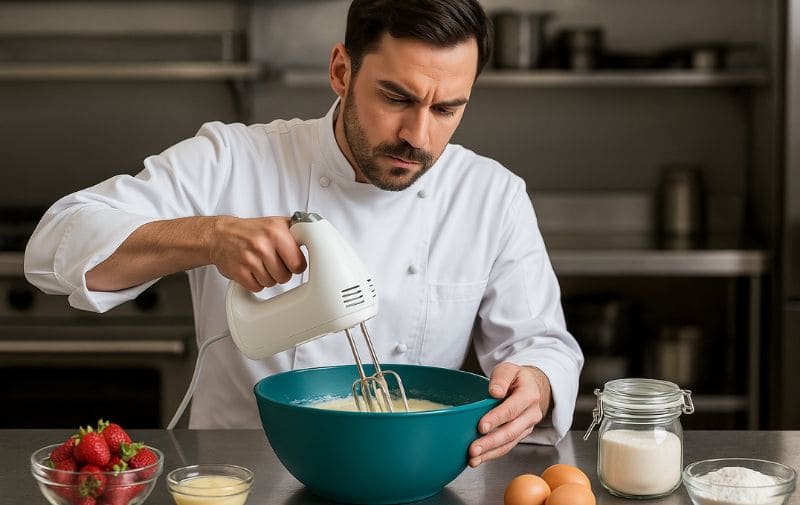So, you’re wondering if you can use a hand mixer in a melamine bowl, or perhaps an electric one? The short answer is: it depends, but proceed with caution. While convenient, using mixers in melamine bowls isn’t always a straightforward “yes.” This guide dives deep into whether it’s a smart move for your kitchen tasks or a potential recipe for damaging your favorite bowls in 2025.
Last Updated: June 2025 | Estimated Reading Time: 7 minutes
First Things First: Can You Generally Use a Mixer in Melamine Bowls?
Many people reach for melamine bowls for mixing because they’re lightweight, less prone to breaking than glass, and often come in cheerful colors. Current advice, including general information often found online, suggests that while occasional, careful use of a hand mixer might be acceptable, it’s not without risks. Melamine’s hard surface can seem ideal for mixing.
However, it’s crucial to understand the difference between surface hardness and true scratch resistance against the concentrated force of metal beaters. While great for everyday bumps and utensil use during meals, the rapid, focused action of mixer beaters presents a different challenge.
Kitchen Tip: Just because a bowl is tough doesn’t mean it’s invincible against all kitchen tools! Think of it like a phone screen – durable, but a direct scrape with something sharp can still leave a mark.
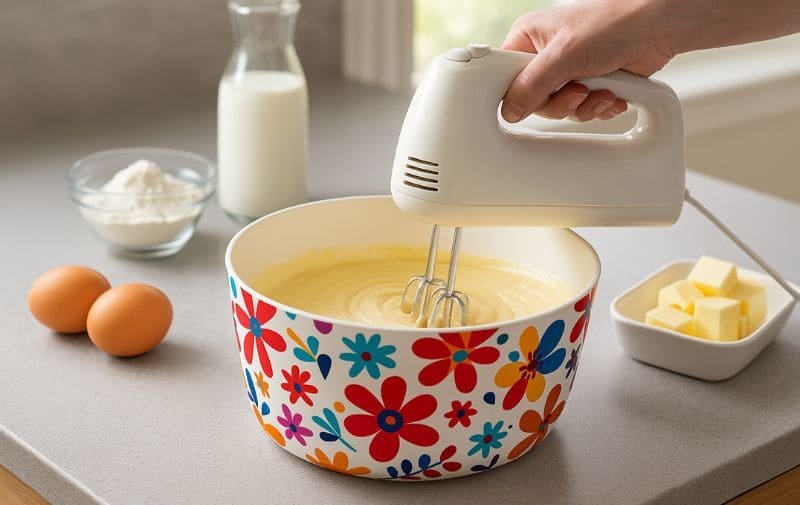
Understanding Melamine: Strengths & Limits for Mixing
To understand if you can use an electric mixer in a melamine bowl, let’s look at the material itself.
What Exactly is Melamine? (A5, Bamboo Fiber Variations Explained)
Melamine is an organic-based, nitrogen-rich compound. When combined with formaldehyde, it forms a durable thermosetting plastic resin. This resin is then molded into tableware. It’s popular because it’s lightweight, highly break-resistant compared to ceramic or glass, dishwasher-safe (with caveats), and can be produced in a vast array of colors and patterns.
- A5 Melamine: This often signifies 100% melamine resin, prized for its higher purity, greater durability, better heat resistance (though still not for microwaves/ovens), and glossier finish. It’s generally considered food-grade and more robust.
- A1 Melamine: May contain a lower percentage of melamine resin (e.g., 30%) mixed with other components like urea-formaldehyde resin, making it more budget-friendly but potentially less durable and with a duller finish.
- Bamboo Fiber Melamine: This type incorporates bamboo powder as a filler with melamine resin. It’s often marketed as a more eco-conscious option, retaining much of melamine’s durability while adding a unique aesthetic.
Surface Showdown: Melamine vs. Glass vs. Stainless Steel for Mixers
When it comes to mixers, how does melamine stack up against traditional mixing bowl materials?
| Feature | Melamine (High Quality A5) | Glass (Tempered) | Stainless Steel | Your Mixing Implications |
|---|---|---|---|---|
| Weight | Lightweight 👟 | Heavy 🏋️♀️ | Medium-Light ⚖️ | Melamine is easy to handle but may need stabilizing. Glass is stable but heavy. |
| Break Resistance | High (shatter-resistant) | Medium (can shatter) | Very High (can dent) | Melamine is forgiving if dropped; less worry about shattering. |
| Scratch Risk (Mixer) | Moderate to High (metal beaters) | Low | Very Low (but can show fine scuffs) | Melamine is most prone to visible scratches from mixers. Glass and steel are much more resilient here. |
| Reactivity | Non-reactive with most foods | Non-reactive | Non-reactive (generally) | All are generally good for common ingredients. |
| Heat (Microwave) | No 🚫 | Yes (check manufacturer) ✅ | No 🚫 | Never microwave melamine. Some glass is microwave-safe. |
The Crucial Difference: Hardness vs. Scratch Resistance High-quality A5 melamine boasts a very hard surface, contributing to its overall durability and resistance to shattering. However, “hard” does not equate to “scratch-proof,” especially against the focused, repetitive action of metal mixer beaters.
While melamine resists scratches from everyday cutlery during dining fairly well, the concentrated force and speed of beaters can, over time, cause superficial scratches or dull the bowl’s glossy finish. Deep gouges are less common with quality melamine unless significant force is applied or sharp-edged beaters are used aggressively.
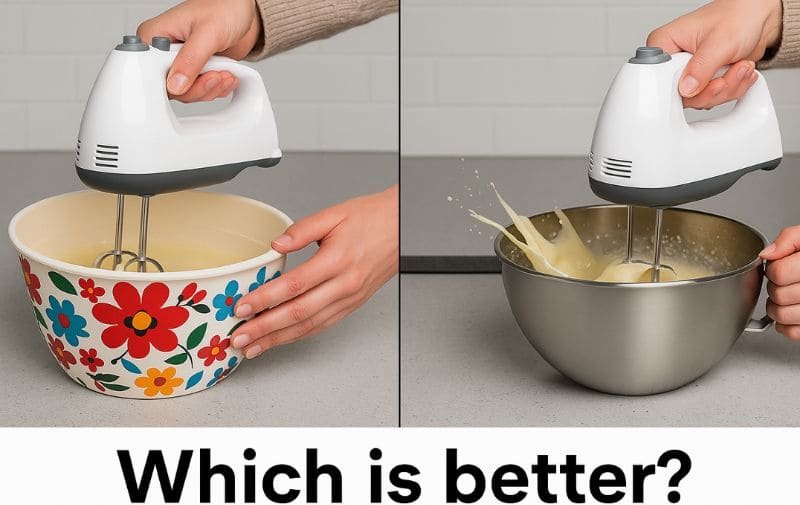
The Quality Question: Does Melamine Grade (A5 vs. A1) Matter for Mixer Use?
Yes, significantly!
- A5 melamine (often marketed as 100% melamine) is denser, more durable, and has a harder, more resilient surface finish. This makes it more resistant to the occasional, careful use of a hand mixer compared to lower grades.
- A1 melamine or melamine mixed with higher percentages of urea may be softer and more prone to scratching and wear.
Buyer’s Tip: If you anticipate even occasional mixer use, investing in bowls clearly stated as high-quality A5 melamine is a wiser choice. Look for reputable brands and clear material specifications.
The Big Question: What Really Happens When Mixer Meets Melamine?
Let’s get down to the nitty-gritty of using that mixer in melamine bowls.
The Scratch Factor: How Likely Are Mixer Beaters to Damage the Surface?
It’s quite likely, especially over time and with metal beaters.
- Hand Mixers: Generally pose a moderate risk. The likelihood of scratching depends on beater type, speed, pressure, and how often you let the beaters scrape the bowl’s surface.
- Electric Stand Mixers: These often have more powerful motors and the beaters are designed to work closely with the specific bowl they come with (usually stainless steel or glass). Using a stand mixer’s beaters in a separate melamine bowl is generally not recommended due to fit and force.
- Immersion Blenders (Stick Blenders): Avoid using immersion blenders with sharp metal blades directly in melamine bowls. The high speed and sharp edges pose a significant risk of damaging the bowl and potentially dislodging material.
Industry Insight: The Beater Type Matters Significantly. Standard metal wire beaters or flat beaters are the most common culprits for scratching melamine. If your hand mixer has silicone-coated beaters, or if you can find aftermarket ones, these are far kinder to melamine surfaces and dramatically reduce the risk of scratching.
Beyond Scratches: Can Mixers Crack or Chip Melamine Bowls?
While the main surface of a quality melamine bowl is robust, chipping or cracking is possible under certain conditions:
- Edge Impacts: The rim or edge of a melamine bowl can be more susceptible to chipping if struck hard by a metal beater, particularly if the bowl is older or made from lower-grade melamine. Try to keep beaters within the main body of the bowl.
- Force & Vibration: Extremely powerful mixers or very prolonged, high-speed mixing of dense ingredients could theoretically stress the bowl, but cracking from vibration alone is less common with good quality bowls than direct impact damage.
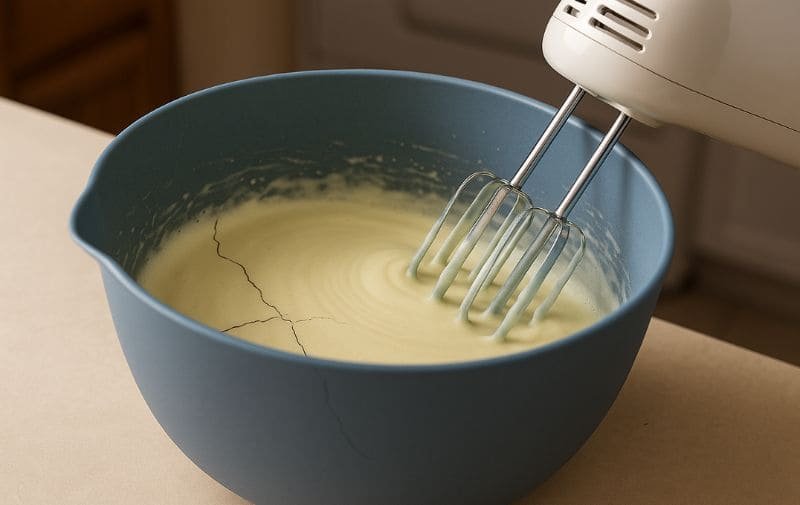
Melamine Dust/Particles: A Real Concern or Overblown Fear?
If significant, deep scratching or gouging occurs, there’s a theoretical risk of tiny melamine particles being dislodged.
Safety Deep Dive: With high-quality, food-grade A5 melamine, used as intended (e.g., not microwaved, not used with highly acidic foods for prolonged periods at high heat), the risk of harmful chemical leaching or particle transfer from superficial scratches is considered very low by regulatory bodies like the FDA. However, if you observe deep gouges, flaking, or significant degradation of the surface, it’s best to retire the bowl from food use, especially for mixing.
Scratches in Melamine: More Than Just a Cosmetic Flaw?
So your melamine bowl gets scratched by a mixer. Is it a big deal?
Food Safety Implications: Do Scratches Compromise Your Bowl?
Yes, potentially.
- Bacteria Harboring: Scratches, especially deeper ones, can create tiny crevices where food particles can lodge and bacteria can grow, making the bowl harder to clean and sanitize effectively.
- Cleaning Challenges: A roughened, scratched surface may not clean as easily in the dishwasher or by hand, potentially leaving residues. While melamine itself is non-porous, deep scratches can compromise this.
Impact on Longevity & Appearance
Scratches will dull the glossy finish of your melamine bowls over time, making them look worn. While this is primarily aesthetic, heavily scratched bowls may also become more prone to staining.
Practical Tip: Regularly inspect your melamine bowls, especially if used with mixers. Run your fingernail over the surface. If you feel deep etches or see material flaking, it’s time to relegate that bowl to non-food uses or discard it.
Smart Mixing: Best Practices If You Use a Mixer in Melamine Bowls
If you choose to use a mixer in melamine bowls, follow these tips to minimize risks:
- Start Slow: Always begin mixing on the lowest speed and only increase as necessary. This reduces splatter and the force with which beaters might hit the bowl.
- Center is Best: Try to keep the beaters in the center of the ingredients and avoid constantly scraping the bottom or sides of the bowl.
- Choose Beaters Wisely: If available, opt for silicone-coated beaters. They are significantly gentler on melamine surfaces.
- Stabilize Your Bowl: Melamine bowls are light. Place the bowl on a non-slip silicone mat or a damp kitchen towel to prevent it from sliding around while you mix. Use your other hand to steady the bowl.
- Consider the Task:
- Lower Risk: Whipping cream, egg whites, or mixing thin batters.
- Higher Risk / Avoid: Mixing very stiff cookie doughs, thick batters, or anything requiring prolonged, high-power mixing. The increased force and potential for beaters to “grab” and scrape are higher.
- The “Sacrificial Bowl” Idea: Some home cooks designate one less-loved melamine bowl specifically for mixing tasks, accepting that it will wear out faster. Given the affordability of some melamine, this can be a pragmatic approach if you understand the risks.
When Melamine Isn’t Your Mixing Ally: Superior Alternatives
For frequent, heavy-duty mixing, or if you simply want to preserve your melamine, certain materials are better choices.
Recommended Bowl Materials for Frequent/Heavy-Duty Mixing
| Material Icon | Pros | Cons | Best For | |
|---|---|---|---|---|
| Stainless Steel | ⚙️ | Durable, lightweight, non-reactive, won’t chip/break, chills quickly. | Can’t microwave, can be noisy, some prefer not to use with very acidic ingredients long-term. | Almost all mixing, especially with hand mixers. |
| Glass (Tempered) | 💎 | Non-reactive, clear (see mixing), microwave/oven-safe (check). | Heavy, can break/chip if dropped. | General mixing, tasks requiring microwaving. |
| Ceramic | 🏺 | Often decorative, can be oven-safe (check), stable due to weight. | Can chip/crack, can be heavy. | Lighter mixing tasks, serving. |
Advantages of Alternatives Specifically for Electric Mixers
- Stability: Heavier glass and ceramic bowls are less likely to move during mixing. Stainless steel bowls with non-slip bases also offer good stability.
- Durability: Stainless steel and tempered glass can withstand the force of electric mixers without scratching or degrading.
- No Material Transfer Risk: With glass and stainless steel, concerns about material particles from scratching are virtually nil.
2025 Melamine Mixing Bowl Insights & The Future
While core melamine properties remain, manufacturers continually innovate. We might see more offerings with enhanced surface coatings for better scratch resistance, though metal beaters will always pose a challenge. Consumer awareness regarding material suitability for specific tasks is growing. People are making more informed choices about when to use their beautiful melamine and when to opt for a workhorse stainless steel or glass bowl.
The sustainability angle continues to be important, with bamboo fiber melamine and other partly plant-based melamine composites gaining traction. While offering an eco-friendlier profile, their fundamental resistance to mixer scratches will be similar to traditional melamine of comparable quality, as the melamine resin is still the primary binder and surface component.
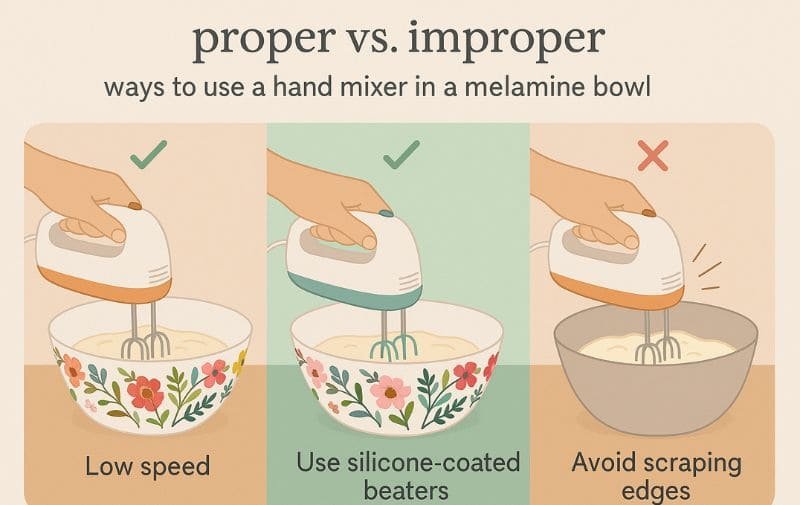
So, What’s the Final Verdict on Mixers and Melamine Bowls?
Using a mixer in melamine bowls is a qualified “sometimes.” It’s generally NOT advisable for regular or heavy-duty mixing, especially with metal beaters on an electric mixer. The risk of scratching, dulling the finish, and potentially creating areas for bacteria to hide is significant over time.
When it might be okay (with caution):
- Infrequent, light tasks (e.g., whipping a small amount of cream).
- Using a hand mixer on the lowest speed.
- If you have silicone-coated beaters.
- With a high-quality (A5 grade) melamine bowl that you don’t mind showing some wear eventually.
When you should DEFINITELY opt for a different bowl type:
- Mixing heavy or dense batters/doughs.
- Using an electric mixer frequently.
- If your melamine bowl is older, lower grade, or already scratched.
- If you want to keep your melamine bowls in pristine condition.
- Using an immersion blender with metal blades.
Ultimately, you need to weigh the convenience against the potential for wear and tear on your melamine.
FAQ: Your Melamine Mixing Questions Answered
Q1: Can you use a hand mixer in a melamine bowl without scratching it?
It’s difficult to guarantee no scratches over time, especially with standard metal beaters. Superficial scratches are likely with repeated use. Using silicone-coated beaters and low speeds can significantly reduce the risk.
Q2: Is it safe to use an electric mixer in a melamine bowl if it’s A5 grade?
A5 grade melamine is more durable and resistant than lower grades. While “safer” in terms of structural integrity, it will still be prone to surface scratching from metal beaters of an electric mixer over time. The food safety aspect of A5 melamine itself is generally good, provided it’s not heated improperly.
Q3: What happens if my melamine bowl gets scratched by a mixer? Is it still food safe?
Superficial scratches primarily affect aesthetics. However, deeper scratches can harbor bacteria and make cleaning less effective. If scratches are deep or the surface is flaking, it’s best to stop using it for food. Always ensure it’s cleaned thoroughly.
Q4: Are bamboo fiber melamine bowls more or less prone to scratching from mixers?
Bamboo fiber melamine bowls will have similar scratch resistance to traditional melamine of comparable resin quality. The bamboo fiber is a filler; the surface properties are largely determined by the melamine resin. They are not inherently more scratch-proof against mixers.
Q5: What are the best bowls for a hand mixer if I want to avoid damaging them? Stainless steel bowls are an excellent choice as they are durable, lightweight, and highly resistant to scratching from mixers. Heavy glass bowls are also very good as they don’t scratch easily and provide stability.
Q6: My melamine bowl feels rough at the bottom after using a mixer, what should I do?
A rough feeling indicates the surface has been abraded, likely by the mixer beaters. Inspect it for deep scratches or pitting. If it’s significantly roughened, it will be harder to clean properly and could harbor bacteria. Consider discontinuing its use with mixers or for wet foods that are hard to clean.
Conclusion: Mixing Smart with Melamine
Melamine bowls are fantastic for serving, light prep, and their sheer good looks. However, when it comes to pairing them with your hand mixer or electric mixer, it’s a balancing act. While occasional, careful use for light tasks might be acceptable with high-quality A5 melamine and the right precautions, regular or vigorous mixing is best left to more resilient materials like stainless steel or glass.
Your Action Plan:
- Assess your melamine: Is it high-quality A5?
- Consider the task: Light and quick, or heavy and prolonged?
- Check your beaters: Metal or silicone-coated?
- Decide: Risk potential cosmetic wear on your melamine, or reach for a dedicated mixing bowl made of stainless steel or glass to keep your melamine looking its best for years to come.
By understanding the properties of melamine and the forces involved in mixing, you can make the smartest choice for your kitchenware and your culinary creations.
Recommended Links:
- Understanding A5 Melamine Quality for Your Tableware
- FDA – Melamine in Tableware Questions and Answers
- Wikipedia – Melamine Resin (For general information on the material)

